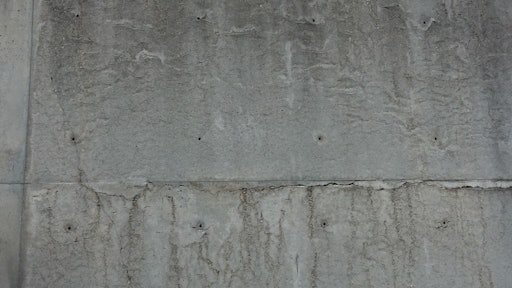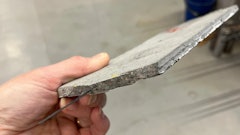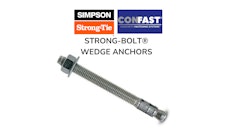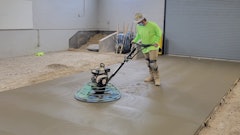
Question: I constructed a basement foundation for a home owner last week with a new set of aluminum forms we had just received. With work increasing I didn’t have the time to wait for pre-treatment on the forms and I didn’t have the chance to condition the forms like I would have normally. After the forms were stripped, the owner contacted us through the architect to inform us that they had structural concerns for the condition of the wall and expected us to tear the walls out or provide an approval from a licensed engineer endorsing the walls for performance – Foundation Contractor (Arkansas).
Answer: Thank you for directing this technical inquiry to our attention. As Executive Director for the CFA and as Chair for the ACI 332 Residential Concrete Committee responsible for ACI 332-XX Requirements for Residential Concrete, I have been part of this conversation of aluminum and concrete for quite some time. I am repeatedly surprised by the design industry’s lack of understanding for the issues related to aluminum and concrete and positioning with an overly-conservative viewpoint.
You have asked my interpretation of the building code issues as they relate to the presence of aluminum as a forming material for concrete. I can tell you, with absolute certainty, that there is no provision of a current building code, commercial or residential, that prevents the use of aluminum forms for any concrete construction method, including that of vertical cast-in-place walls.
The primary references for residential codes, or mandatory compliance would be the IRC1 and ACI 332-142. A common statement in the IRC can be found in R402.2 Concrete:
…Materials used to produce concrete and testing thereof shall comply with the applicable standards listed in Chapters 19 and 20 of ACI 318 or ACI 332.
Before moving on to ACI 332, however, note that in the IRC, Section R404.1.3.3.6 Form materials and form ties, states:
…Forms shall be made of wood, steel, aluminum, plastic, a composite of cement and foam insulation, a composite of cement and wood chips, or other approved material suitable for supporting and containing concrete.
Here direct reference is given to the acceptability and general practice of cast-in-place forming for residential wall construction using aluminum forms.
The first official release of a concrete code for new construction other than ACI 318 was ACI 332-04, designed to be a companion code to the projects under the jurisdiction of the IRC. A review of ACI 332’s residential concrete code notes that there is zero reference to aluminum offered in the discussion throughout the document. Aluminum is not a common structural element seen used or attempted for use to be embedded in concrete walls (e.g. an anchor bolt or wind strap). This is because the code is minimum requirements only. ACI 332 produces another document, ACI 332R3 where the committee does discuss the presence of aluminum in proper use for concrete construction. Section 3.7.2 Metal, states:
…Aluminum that has not been treated or properly cured for use in forming concrete will produce a reaction with the alkali resulting in a damaged finished surface. These forms can be chemically treated or cured through a minimum of two contacts with concrete placements to prevent the affected surface conditions.
To be noted here is the reference to “finished surface” as the finished surface is not the structural condition for the wall. ACI’s Concrete Terminology, the common definition standard for all ACI documents provides two guiding definitions:
Finish — The texture of a concrete surface after consolidating and finishing operations have been performed.
Finishing — Leveling, smoothing, consolidating, and otherwise treating surfaces of fresh or recently placed concrete or mortar to produce desired appearance and service.
The finish, the surface condition of a concrete element is cosmetic and an issue of durability (i.e. frozen concrete affecting freeze/thaw cycling durability) rather than affecting the inherent nature of the structural performance.
The primary technical issue is that a reaction between aluminum and concrete produces hydrogen that results in one of two concerns, the hydrogen bubbles try to work out of the concrete surface and create lines, trails or pocks and if sustained contact lasts long enough, the aluminum cross-section itself is reduced…not that of the concrete.
There is no report or evidence in any building code authority or in technical guide reference to corroborate a concern for the structural integrity of the concrete when in contact with aluminum rather than aluminum that has been embedded. In fact, ACI 303R-044 states:
Aluminum, magnesium, and zinc all react with alkaline material in concrete, liberating hydrogen gas that causes sticking and bubbling on forms containing these metals. Extreme care and attention is needed to minimize these effects. Therefore, these materials should not be used to produce architectural concrete.
It is for these purposes, that aluminum form manufacturers offer pre-treated aluminum forms or concrete contractors condition their new forms with several non-exposed or test placements until the raw aluminum has been conditioned to be non-reactive with the concrete.
The surface condition for any concrete wall placed with untreated aluminum forms is a surface that can, if necessary or required, be finished just like any standard concrete architectural element that has remediation work to be performed. There are a variety of patching components that are available for the finish work on exposed concrete surfaces. Otherwise, any waterproofing or other coating will more than suffice in completing the work for long term, durable performance of non-exposed conditions. A cosmetic issue with a wall should never be a condition for failure to approve the structural performance unless it is first investigated by a licensed design professional that is fully knowledgeable of the conditions for the service of the structural element. However, contractors should always inform their client of the finished condition that they are prepared to deliver and communicate the options to the client for accepting or upgrading those finished provisions.
Ed. Note: Jim Baty is the CFA Executive Director. He can be reached at (866) 232-9255 or by email at [email protected].
References:
- 2012 International Residential Code For One- and Two-Family Dwellings published by the International Code Council, Inc., 4051 West Flossmoor Road, Country Club Hills, IL 60478-5795 | Phone 1-888-422-7233 | www.iccsafe.org
- Residential Code Requirements for Structural Concrete (ACI 332-14) and Commentary published by the American Concrete Institute, 38800 Country Club Drive, Farmington Hills, MI 48331 | Phone: 248-848-3700 | www.concrete.org
- Guide to Residential Concrete (ACI 332R-06) published by the American Concrete Institute, 38800 Country Club Drive, Farmington Hills, MI 48331 | Phone: 248-848-3700 | www.concrete.org
- Guide to Cast-in-Place Architectural Concrete Practice (ACI 303R-04) published by the American Concrete Institute, 38800 Country Club Drive, Farmington Hills, MI 48331 | Phone: 248-848-3700 | www.concrete.org


























